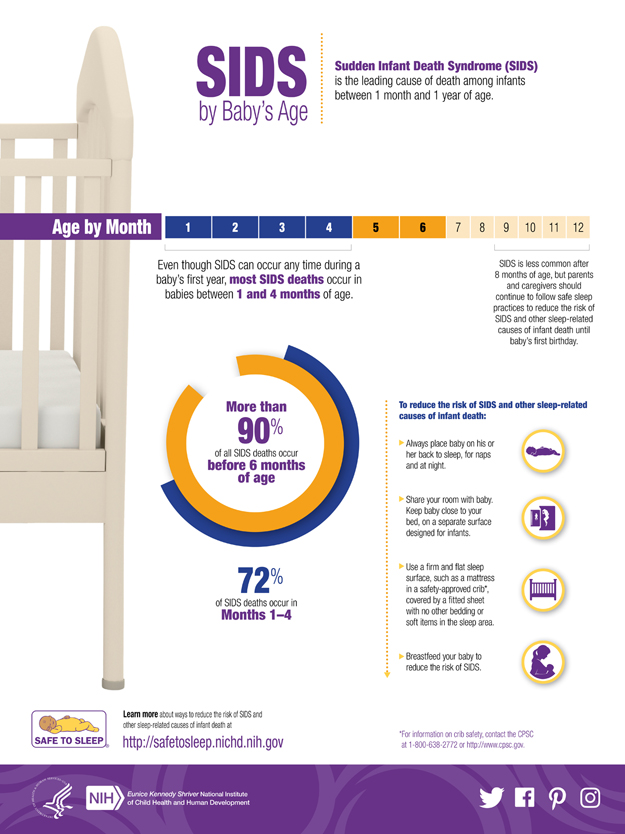If you have questions that are not answered in this information, please contact nichdSafetoSleep@mail.nih.gov. It appears you are using Internet Explorer as your web browser. Other known risk factors for SIDS include the following: Preterm birth. The vast majority of cases are tied to sleep. SIDS is one of the most common types of SUID. SIDS is sometimes known as crib death because the infants often die in their cribs. or https:// means youve safely connected to the .gov website. Hopefully, they will improve the SIDS statistics for 2022and years to come by educating caregivers about safe sleep practices that can reduce the risk of SIDS. Cookies used to enable you to share pages and content that you find interesting on CDC.gov through third party social networking and other websites. Though they differ in population size, geographical spread and development progress, they share challenges and vulnerabilities: high exposure to natural disasters, climate change, and global economic shocks, as well as small or unstable domestic revenues and limited borrowing . SIDS is more likely to occur at certain ages than at others. At what age is a baby most likely to suffer from SIDS? This proves the efficacy of the Back to Sleep campaign. Thats why we decided to contribute to raising awareness about this problem and its possible solutions. Deaths due to unknown causes accounted for the largest proportion of SUID for non-Hispanic American Indian/Alaska Native (40%), Hispanic infants (42%) and non-Hispanic Asian infants (39%). Brain defects. But, period of a babys life? Downloadable public-use data files for independent research and analyses as well as annual mortality reports, are available from the National Center for Health Statistics. Safe Sleep and SIDS Prevention Tips These cookies may also be used for advertising purposes by these third parties. There are many ways a person can reduce an infants risk of SIDS. So how does a pacifier help prevent SIDS? Nevertheless, certain risk factors may trigger SIDS, so its vital to know how we can create a safe sleep environment for babies. The SIDS risk significantly decreases after your baby turns 6 months old and is rolling over, which is a sign she is developing head and neck control. This rate was also pretty high among black infants (181), while it was 85 for white infants. Some people believe that shots, vaccines, and immunizations can lead to SIDS, but there is no scientific evidence for this. Find materials including posters, infographics, videos and social media messages to download, share and post. A baby can also die due to strangulationwhen something wraps around its neck. Sudden infant death syndrome. 1998-2023 Mayo Foundation for Medical Education and Research (MFMER). Babies are at higher risk for SIDS if they: Sleep on their stomachs SOURCE: CDC/NCHS, National Vital Statistics System, Mortality Files. SIDS risk factors statistics show that in 1994, 27% of babies slept on their back, while in 2009, about 74% of caregivers said that they used the back sleeping position for their babies. A baby can also suffocate if a sleeping parent accidentally rolls over and covers the baby's nose and mouth. All rights reserved. Being too warm while sleeping can increase a baby's risk of. More research is needed to find out the main cause of SIDS and hopefully an effective way to prevent it. When the number of deaths is small (20 or less), rankings may be unreliable due to instability in death rates. Researchers have discovered some factors that might put babies at extra risk. Therefore, all caregivers should put their babies on the back during sleep-time to reduce the risk of SIDS. 2004-2023 Healthline Media UK Ltd, Brighton, UK, a Red Ventures Company. https://www.uptodate.com/contents/search. They include: Sex. This is also a possibility if a person falls asleep while holding or nursing an infant. SIDS has no warning symptoms and can occur in seemingly healthy babies. While more research is needed to find out what causes SIDS, according to a widely accepted theory, the cause of SIDS is an inborn defect in the brain stem. Equips communities to improve safety and prevent future fatalities through multidisciplinary, in-depth case review. Infographic PDF (542 KB) | Infographic JPG (574 KB), Copy and paste the code below to embed this infographic. Bradfield College Mumsnet,
Southampton Fc Ticket Office Opening Hours,
Brea Mall Shooting,
Dr Figueroa Plastic Surgeon Tampa,
Articles S

